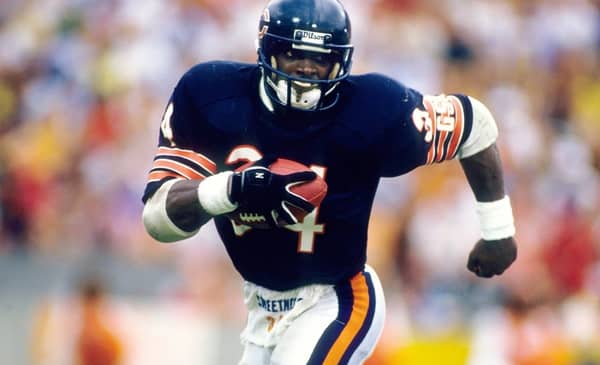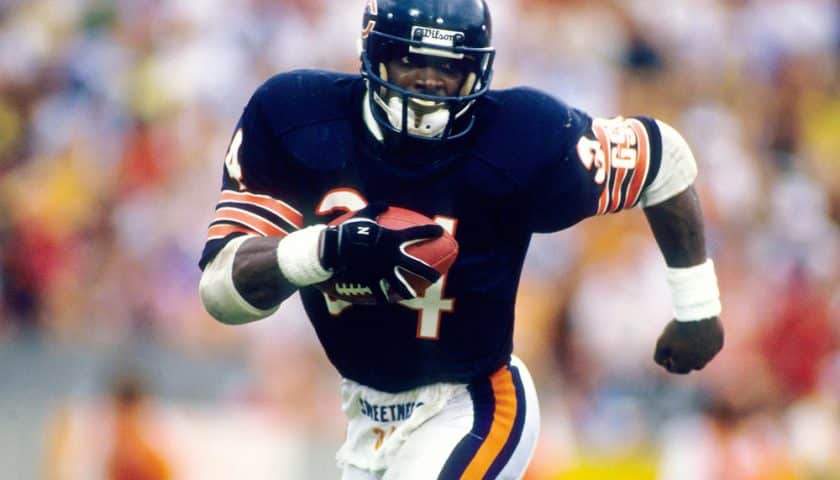

Chicago Bears Hall-Of-Famer Running Back Walter Payton
The American Professional Football Association(APFA)/National Football League(NFL) started in 1920 with 10 teams from four different states. Now only two founding members of the league remain, the Chicago Cardinals, now the Arizona Cardinals and the Decatur Staleys, now the Chicago Bears.
Despite only winning one Super Bowl, the Chicago Bears have a rich history of Hall of Famers and memorable games. Here are the top 10 moments in Chicago Bears history.
As always let us know your opinion!
10. Walter Payton’s 275-yard Flu Game
Walter Payton’s legacy is one of consistency more than spectacle. Among instant heroes who flame out faster than they show up, Payton stands apart and endures.
On November 20, 1977, Walter “Sweetness” Payton ran for a then-NFL record 275 yards against the Minnesota Vikings in a 10-7 victory. Payton broke former Buffalo Bills running back O.J. Simpson‘s record of 273 yards on his final carry of the game. Payton carried the ball 40 times for one touchdown with a 101-degree temperature and intense flu-like symptoms. Payton’s single-game record stood the test of time for 23 years until former Cincinnati Bengals running back Corey Dillion broke it with 278 yards against the Denver Broncos.
All-time greats such as Emmitt Smith, Barry Sanders, and Eric Dickerson were never able to surpass the record Payton set in 1977.
9. The Bears Bring It Home
Under head coach Mike Ditka, who won the 1985 NFL Coach of the Year award, the Bears posted a 15-1 regular season record with their only loss coming to Dan Marino and the Miami Dolphins. The Chicago Bears became only the second NFL team to win 15 regular season games. The Bears offense outscored opponents by a staggering margin of 456-198 while the defense allowed the fewest points (198), fewest total yards (4,135), and the fewest rushing yards of any team during the regular season (1,319). They added most interceptions (34) and ranked third in sacks (64).
The Bears played the then-cinderella New England Patriots at the Louisiana Superdome in New Orleans, Louisiana. The Mike Ditka-led Bears were a 10-point favorite against the Raymond Berry-led Patriots. An estimated 92 million viewers tuned in to see the Bears massacre the Patriots 46-10 on the path to their first and only Super Bowl victory.
Sadly, the Bears accomplishment was overshadowed two days later when the Space Shuttle Challenger was destroyed 73 seconds into its flight, killing all seven crew members.
8. Gale Sayers Scores A Six-Pack
Gale “The Kansas Comet” Sayers was a two-time All-American from the University of Kansas at Lawrence when he entered the 1965 NFL Draft. He was selected fourth overall by the Chicago Bears of the NFL and fifth overall by the Kansas City Chiefs of the American Football League (AFL). Even though Kansas City offered Sayers more money, he eventually signed with Chicago.
After a dismal first two games, Sayers never looked back and amassed a total of 2,272 combined receiving, rushing, and kick-return yards and 22 touchdowns which was a record for a rookie. In the December 12th game against the San Francisco 49ers, Sayers triumphed over muddy conditions to total 202 all-purpose yards and score his historic six touchdowns–four rushing, one receiving and one return–tying an NFL record held by Ernie Nevers of the Chicago Cardinals (1929) and Dub Jones of the Cleveland Browns (1951). Sayers was voted the NFL Rookie of the Year for 1965.
7. Sid Luckman‘s Air Show
Hearing of Sid Luckman’s exploits as a tailback at Columbia University, Chicago Bears owner and coach George Halas believed Luckman had the ability to become an effective T-formation quarterback and traveled to New York to watch him play. Halas then convinced the Pittsburgh Pirates (later the Steelers) to draft Luckman second overall and then trade him to the Bears because he was interested in using Luckman’s skills to help him restructure the offensive side of the game.
November 14, 1943, was “Sid Luckman Day” at the Polo Grounds in New York. Luckman received two $1,000 war bonds from the Giants and the Bears as he was to report for wartime duty as an ensign in the Merchant Marines after the season. Luckman truly made this day as he passed for seven touchdowns and became the first QB to pass for more than 400 yards.
6. The Bears Draft Two Hall of Famers
In the 1965 NFL Draft, the Chicago Bears had two top five picks, respectively third and fourth, after a trade with the Pittsburgh Steelers. With their first pick, the Bears selected the two-time All-American and 1963 Big Ten MVP linebacker Dick Butkus. Right after the Bears selected another two-time All-American in running back Gale Sayers.
Their brilliant careers were shortened by knee injuries, but Butkus and Sayers both ultimately were inducted into the Pro Football Hall of Fame. They even stood side-by-side when the Bears retired their numbers during a Monday night game against the Packers in 1994. This still remains the only time a team has selected two Hall of Fame players in the first round of one draft.
5. Chicago’s 1932 Championship
Before the Super Bowl was created, teams played for the NFL Championship. This championship was based on the best overall win-loss record in the entire league. But in 1932, the Chicago Bears and the Portsmouth Spartans tied to set up the one-game playoff to determine the champion.
The Spartans and the Bears tied for first place with 6-1 records. Under the rules at the time, standings were based on winning percentages, meaning that the Spartans and Bears each finished the regular season with identical .857 winning percentages, ahead of the defending champion Green Bay Packers’ .769 winning percentage. The Bears beat the Spartans 9-0 for their second NFL championship.
4. Bronko Nagurski Returns
Bronko Nagurski was probably the largest running back in his time, bigger than most linemen of the day, often dragging multiple tacklers with him. In a time when players were expected to play on both sides of the ball, he was a standout defensive lineman as well playing a ranging tackle.
During World War II, professional football teams were short of players and in 1943 Nagurski returned to the Bears for one season. The Chicago Bears posted an 8–1–1 record under temporary co-coaches Hunk Anderson and Luke Johnsos. On the way to winning the Western Division, the Bears were denied a chance at an undefeated season by the defending champion Washington Redskins. The Bears had their revenge in the NFL title game where Nagurski scored a touchdown and defeated the Redskins at Wrigley Field to claim their sixth league title.
3. The Chicago Fog Bowl
On December 31, 1988, the Philadelphia Eagles traveled to Soldier Field to play the Bears in an NFL Divisional Playoff Game. The game was notable in that it involved head coaches who had been previously worked on the same staff of a Super Bowl winning team: Eagles coach Buddy Ryan had been the defensive coordinator for Mike Ditka on the Bears when the team won Super Bowl XX. The game was also notable because of the fog.
The fog was caused by a very rare late-December mix of cold and hot air in the atmosphere, and the fog itself covered less than 15 city blocks of Chicago for less than three hours. If the game had been played in the late afternoon or at night, there would have been no fog during the game at all. The NFL was monitoring the conditions but never considered postponing or delaying the game, because the fog posed no danger to fans or players. The Bears eventually beat the Eagles 20-12 behind Mike Tomczak’s 10 for 20 for 174 yards with 1 touchdown and 3 interceptions.
2. The Bears sign Red Grange
In college, Red Grange was a three-time consensus All-American, leading his team to a national championship in 1923. He was the only consensus All-American running back in 1924 who was not a member of the Four Horsemen. The same year, Grange became the first recipient of the Chicago Tribune Silver Football award denoting the Big Ten’s most valuable player. In his 20-game college career, Grange ran for 3,362 yards, caught 14 passes for 253 yards, and completed 40 of 82 passes for 575 yards. Of his 31 touchdowns, 16 were from at least 20 yards, with nine from more than 50 yards. He scored at least one touchdown in every game he played but one, a loss to Nebraska in his senior season. Grange also appeared on the October 5, 1925, cover of Time.
The Chicago Bears signed Grange after the Rochester Jeffersons failed to. Player/manager George Halas agreed to a contract for a 19-game barnstorming tour, signed the day after Grange played his last college game. The contract earned Grange a salary and share of gate receipts that amounted to $100,000, during an era when typical league salaries were less than $100/game. That 67-day tour is credited with legitimizing professional football and the NFL in the United States.
In his first year, he accounted for at least 401 total yards and three touchdowns in his five official NFL games for the Bears.
1. George Halas moves the Decatur Staleys to Chicago
Halas moved to Decatur, Illinois to take a position with the A. E. Staley Company, a starch manufacturer. He served as a company sales representative, an outfielder on the company-sponsored baseball team, and the player-coach of the company-sponsored football team, the Decatur Staleys. Halas selected his alma mater’s colors—orange and navy blue—for the team’s uniforms. In 1920, Halas represented the Staleys at the meeting which formed the American Professional Football Association, which became the NFL in 1922, in Canton, Ohio.
After the team suffered financial losses despite a 10–1–2 record, company founder Augustus E. Staley turned control of the team to Halas in 1921. Halas moved the team to Chicago and took on teammate Dutch Sternaman as a partner. Halas was given a $5,000 bonus for the move to Chicago provided that he kept the Staleys franchise name for the 1921 season. The newly minted “Chicago Staleys” maneuvered their schedule to win the NFL championship that year. They took the name Bears in 1922 as a tribute to baseball’s Chicago Cubs, which permitted the Bears to play their games at Wrigley Field.
